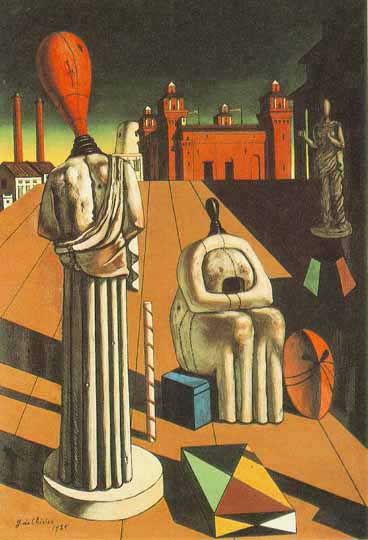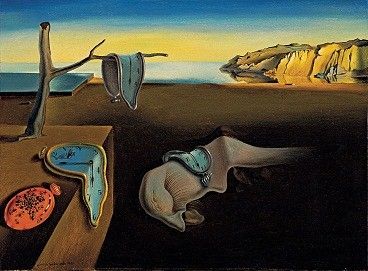Summary of Giorgio De Chirico
Giorgio de Chirico was a pioneer in the revival of Classicism that flourished into a Europe-wide phenomenon in the 1920s. His own interest was likely encouraged by his childhood experiences of being raised in Greece by Italian parents. And, while living in Paris in the 1910s, his homesickness may have led to the mysterious, classically-inspired pictures of empty town squares for which he is best known. It was work in this style that encouraged him to form the short-lived Metaphysical Painting movement, along with the painter Carlo Carrà. His work in this mode attracted considerable notice, particularly in France, where the Surrealists championed him as a precursor. But de Chirico was instinctively more conservative than the Paris avant-garde, and in the 1920s his style began to embrace qualities of Renaissance and Baroque art, a move that soon drew criticism from his old supporters. For many years afterwards, the Surrealists' disapproval of his late work shaped the attitude of critics. The artist's reputation was also not helped by his later habits of creating new versions of his Metaphysical paintings and of backdating his work, as if those pictures had been created back in the 1910s. In recent years, however, his work of that period has attracted more interest, and it was certainly influential on a new generation of Italian painters in the 1980s.
Accomplishments
- De Chirico is most famous for the eerie mood and strange artificiality of the cityscapes he painted in the 1910s. Their great achievement lies in the fact that he treats the scenes not as conventional cityscapes - as perspectives on places full of movement and everyday incident - but rather as the kinds of haunted streets we might encounter in dreams. They are backdrops for pregnant symbols or even, at times, for collections of objects that resemble still lifes. De Chirico's innovative approach to these pictures - an approach rather like that of a theatrical set designer - has encouraged critics to describe them as "dream writings." They are, in other words, disordered collections of symbols. And this points to their difference from the so-called "dream images" of later Surrealists such as Salvador Dalí, which appear to want to capture the contents of a dream with a camera.
- Key to de Chirico's work is his love of the classical past. He came to this through his appreciation for German Romanticism, and it was this that revealed to him new ways of looking at the Classics, and ways of treating themes of tragedy, enigma, and melancholy. For de Chirico, the themes and motifs of the Greek and Roman Classics remained valid even in the modern world. However, he recognized that the clash of the past and present produced strange effects - suggesting sorrow, disorientation, nostalgia - and some of the most powerful qualities in his work of the 1910s come from staging this contrast.
- Much of the impact of de Chirico's pictures is derived from the restrained clarity of his style. He achieved this by rejecting the formal innovations of much modern art since Impressionism and by instead opting for a frank, realistic manner that allowed him to depict objects with simplicity. The result was a style that, rather like René Magritte's, is rich in evocative mystery despite the straightforward character of the depiction.
- De Chirico always believed that his early academic training was vital in preparing him for his later work, and this conservative attitude set him apart from other modernists - particularly from the Surrealists who did so much to elevate his reputation. In the 1920s this outlook grew into a renewed belief in the value of craftsmanship and the Old Masters tradition, and it directed a shift in his style towards greater detail, richer color, and more conventionally accurate modeling of forms and volumes, as well as more emphatic references to Renaissance and Baroque art.
Important Art by Giorgio De Chirico
The Enigma of an Autumn Afternoon
The Enigma of an Autumn Afternoon is the first painting in de Chirico's Metaphysical Town Square series, and the first painting in which he settled upon the style and imagery for which he is now famous - quiet, enigmatic, strangely simplified scenes of old towns. It is also the first in a number of canvases that he titled with the word "enigma." We may speculate that the enigma in question is the relationship between the real and the unreal, as this picture was painted after the artist felt a revelation in Florence's Piazza Santa Croce in which the world appeared before him as if for the first time. The painting depicts a portion of that square in a simplified fashion. It has many of the features that would become hallmarks of his work: a desolate piazza bordered by a classical facade, the long shadows and deep colors of the city at dusk, and a stationary figure, here a statue. The sail visible in the distance may have been inspired by de Chirico's memories of visits he made as a youth to the harbor of Piraeus in Greece.
Oil on canvas - Peggy Guggenheim collection
The Child's Brain
The Child's Brain was a favorite of Surrealism's founder André Breton, who bought the painting reportedly after it caused him to get off his bus when he saw it hanging in a gallery window. One can appreciate its impact on Breton, for almost a decade before the Surrealists had begun to speak about the power of dreams and the unconscious, de Chirico was painting images such as this that spoke about exactly these themes. Breton said that in conversations with de Chirico, the painter revealed that the man depicted in this image was his father. The bookmark inserted into the book on the table symbolizes his parents' lovemaking - the bookmark positioned so as to represent the phallus. On another level, the man in the painting, whether modeled upon de Chirico's father or not, is meant as a portrait of the young, sexually ambivalent and virile Dionysus. Breton and the Surrealists had interpreted de Chirico's work through their readings of psychoanalysis, but Freud was unknown to de Chirico until the 1920s.
Oil on canvas - Moderna Museum, Stockholm
Gare Montparnasse (The Melancholy of Departure)
Not to be confused with a 1917 painting simply entitled The Melancholy of Departure, the present work, Gare Montparnasse (The Melancholy of Departure), was dubbed an "architectonic masterpiece" by Robert Hughes. The presence of the architecture is central to its power, yet it is the way de Chirico treats the architecture that is so innovative; it is not intended to represent a particular place, or environment, but instead it is like a theatrical set - an unreal backdrop for unreal events. It is typical of the artist's work of the 1910s in its use of multiple vanishing points, deep colors, and elongated shadows of dusk. The clock tower and departing train possibly foreshadow his imminent departure to join the Italian army in the First World War. Trains are a familiar motif in de Chirico's work, functioning as a symbol of life and youthful expectation.
Oil on canvas - The Museum of Modern Art, New York

The Disquieting Muses
The muses are another recurring motif in de Chirico's paintings. He believed they inspired the artist to see beyond mere appearances and look into the metaphysical - the realm of memory, mythology and truth. This was originally painted while he was living in Ferrara, around 1917; the city's Castello Estense can be seen in the background. It would later become an inspiration for a Sylvia Plath poem of the same name. Once again, de Chirico disregards the true scale of architecture, and seems to represent it almost as a miniature model in which he can place the symbolic objects of an uncanny still life. At least 18 copies of this painting exist, which were backdated by the artist to suggest that he had painted them in the late 1910s, just like this picture. The practice of producing such copies and backdating them was partly an attempt to profit and, in part, a means of taking revenge on the critics who attacked his later works.
Oil on canvas - Private Collection
Great Metaphysical Interior
This is one of a series of "metaphysical interiors" painted by de Chirico in the later part of this period, while he was living in Ferrara. Like other works in the series, it features a room cluttered with a diverse set of objects, including other framed images, and was influenced by his walks through the city's arcades. The contents of the room are fairly suggestive, but the fact that food features commonly in de Chirico's work from this period has led to the suggestion that the baguettes lying in a coffin-like box are perhaps a reference to his intestinal problems.
Oil on canvas - The Museum of Modern Art, New York

Self-Portrait
This is an example of the many self-portraits de Chirico painted in the 1920s. It presents him as a visionary (heroic) figure, and is reminiscent of self-portraits by Mannerist painters from the 16th century. As de Chirico's work became more conservative in the 1920s, he became increasingly interested in older painting techniques. Here he shows himself contemplating his own image as it would appear in a Classical bust. But the artist is looking beyond the earlier influence, looking at the viewer with a knowledgeable expression displaying his intent in taking his art further.
Oil on canvas - Toledo Museum of Art, Ohio
Biography of Giorgio De Chirico
Childhood
Giorgio de Chirico was born in Volos, Greece to Italian parents. His father was an engineer working on the construction of the Greek railway system and his mother was a noblewoman of Genoese origin. His parents encouraged his artistic development, and from a young age he took a strong interest in Greek mythology, perhaps because Volos was the port the Argonauts were supposed to have set sail from to retrieve the Golden Fleece. However, he was troubled by intestinal disorders in his youth, and it has been speculated that this contributed to his melancholic outlook.
Early Training
From 1903 to 1905, de Chirico studied at the Higher School of Fine Arts in Athens. Upon his father's death in 1905, the family visited Florence before moving to Munich the following year. De Chirico enrolled at the Academy of Fine Arts there and developed a strong interest in Symbolist artists like German Max Klinger and particularly the Swiss painter Arnold Böcklin.
He left Munich before graduating to rejoin his family in Milan in March 1910. Shortly thereafter, he moved to Florence and, via Italian writer Giovanni Papini, began to study German philosophers like Friedrich Nietzsche, Arthur Schopenhauer, and Otto Weininger. De Chirico attempted to relate the work of these men to his painting, seeking to transcend the banal appearances of everyday life and uncover the reality that he believed was concealed beneath.
Mature Period
There were historical, mythological and philosophical themes in de Chirico's paintings throughout his career. He began his Metaphysical Town Square series with Enigma of an Autumn Afternoon (1909) painted in Florence. During this period, which lasted until 1919, there are reoccurring references to memory, loss, mystery, the passing of time, and architecture - particularly arches and towers - in desolate, melancholic squares and cityscapes. They appear to be images of depopulated Mediterranean cities, in a time beyond history - where everyday life is imbued with mythology.
De Chirico and his mother moved to Paris to join his brother in July 1911, passing through Turin along the way. He had been interested in the city as it was the place where Nietzsche had displayed his first signs of madness in 1889. The architecture of the piazzas and archways made a considerable impact on him, and locations in the city can be spotted throughout his paintings from this period.
In May 1915, de Chirico and his brother were enlisted into the Italian army to fight in World War I. Based in Ferrara, de Chirico continued to paint, with the arcades and shop windows of the city appearing in his works. He had begun to use mannequins in pictures he painted in Paris, and these became more frequent in his Ferrara paintings.
In 1917, a nervous condition forced him into an Italian hospital, where he continued to work, producing pictures mainly featuring cluttered interiors in the Metaphysical style. In the hospital he met Carlo Carrà, and through their exchanges Metaphysical art, or pittura metafisica, was born. In early 1919, de Chirico had his first solo show at the Galleria Bragaglia in Rome.
Late Period
De Chirico's later period of work is usually said to start in 1919 and lasted until his death in 1978. In 1919, soon after his first solo show, he had a revelation while contemplating a Titian painting at Rome's Galleria Borghese. He wrote 'The Return of Craftsmanship,' an article that advocated a return to traditional methods and iconography, while simultaneously launching an outspoken campaign against modern art. Previously de Chirico had not taken much interest in technique. Despite his training, his early figurative work revealed an underdeveloped knowledge of anatomy. He sought to remedy this while in Rome, particularly between 1919 and 1924, where he worked on his technique and was inspired by the Old Masters.
During these years, de Chirico's work was also branching into other mediums. In 1924, he worked on designs for a ballet in Paris based on a short story by the Italian dramatist Luigi Pirandello. He made lithographs for a reproduction of Guillaume Apollinaire's book of poems Calligrammes in 1929. In the same year, he wrote his only novel, Hebdomeros. Despite his artistic change of direction, the book's dream-like collection of impressions and situations functions as a literary companion to his metaphysical paintings. By this time De Chirico had distanced himself from the Surrealists, yet Hebdomeros is still considered one of the finest examples of Surrealist literature.
He continued with similar ventures until very late in his life. In the late 1960s, he began creating small bronze sculptures, in which some of the figures were borrowed from his earlier paintings, including the mannequins from his Ferrara period. Throughout the rest of his career he would routinely create and sell copies of paintings from his Metaphysical period, passing them off as originals. The practice was in part an attempt to profit from the popularity of his early work, and in part a means of taking revenge on the critics who heaped praise on it and attacked the styles of his later periods.
The Legacy of Giorgio De Chirico
Although de Chirico's career spanned seventy years, his early metaphysical works are his most significant. He was a major influence on the Surrealists. André Breton claimed that de Chirico was one the main torchbearers of a new modern mythology. For a time he was happy to be courted by the Surrealists, but he later referred to them as "the leaders of modernistic imbecility." Nevertheless, he was also inspirational for later French avant-garde groups such as the Lettrists and Situationists, particularly in relation to their interest in urbanism. These two groups consider de Chirico an architect as much as a painter, seeing in his enigmatic piazzas and towers visions and plans for future cities. Besides the art world proper, de Chirico's influence can be seen on everything from the Italian filmmaker Michelangelo Antonioni's shots of desolate cityscapes and urban anomie to the environments and packaging for the videogame Ico for the Playstation 2. And the novelist V.S. Naipaul has borrowed the title of one of his paintings, The Enigma of Arrival (1911-12), for one of his own books.
Influences and Connections

-
![Arnold Bocklin]() Arnold Bocklin
Arnold Bocklin -
![Raphael]() Raphael
Raphael ![Max Klinger]() Max Klinger
Max Klinger![Hans Thoma]() Hans Thoma
Hans Thoma![Alfred Kubin]() Alfred Kubin
Alfred Kubin
![Friedrich Nietzsche]() Friedrich Nietzsche
Friedrich Nietzsche![Arthur Schopenhauer]() Arthur Schopenhauer
Arthur Schopenhauer![Otto Weininger]() Otto Weininger
Otto Weininger![Giovanni Papini]() Giovanni Papini
Giovanni Papini
-
![Max Ernst]() Max Ernst
Max Ernst -
![Salvador Dalí]() Salvador Dalí
Salvador Dalí -
![René Magritte]() René Magritte
René Magritte -
![Carlo Carrà]() Carlo Carrà
Carlo Carrà ![Sylvia Plath]() Sylvia Plath
Sylvia Plath
-
![Metaphysical Painting]() Metaphysical Painting
Metaphysical Painting -
![Surrealism]() Surrealism
Surrealism ![Lettrism]() Lettrism
Lettrism![Situationism]() Situationism
Situationism
Useful Resources on Giorgio De Chirico
- Giorgio de Chirico: A Metaphysical JourneyBy Gerd Roos, Giorgio de Chirico
- The Art of Enigma: The de Chirico Brothers & the Politics of ModernismOur PickBy Keala Jane Jewell
- The Memoirs Of Giorgio De ChiricoOur PickBy Giorgio de Chirico
- Hebdomeros with Monseiur Dudron's Adventure and Other Metaphysical WritingsBy Giorgio de Chirico, John Ashbery



































